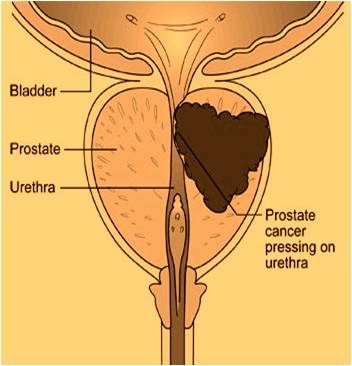What is Prostate Cancer?
Prostate cancer mostly begins in the prostate gland cells called adenocarcinoma. The progression of this cancer is very slow; many men usually die in old age even without even realizing they had this type of cancer. It is only realized when doctors conduct an autopsy. Detection of this cancer is done by a digital rectal exam of the prostate glands.
Autopsy studies record that 80% of men who died in their eighties had this cancer. But none of them knew, including their doctors.
The Prostate Gland

This gland is only found in males. It is situated below the bladder, right in from of the rectum.
The prostate gland is actually a cluster of smaller glands that encircles the top section of the urethra (urinary channel) at the point where it leaves the bladder.
Although the function of the prostate is not entirely clear, the muscles of these small glands help squeeze prostate secretion in the urethra.
Signs and Symptoms of Prostate Cancer
This cancer is difficult to detect and control because the causes are not known. Death rates can be lowered through early detection and awareness of the warning signals. Possible warning signals include:
- Difficulties in urination especially at night
- Urinating more times than usual, particularly at night
- Painful urination
- Blood in the urine
- Inability to empty the bladder completely
- Constant pain in the lower back or hip area
You should report any of the above signs and symptoms to a doctor so that they can be examined. Remember that with cancer, the earlier it is detected the better.
Prostate Cancer Risk factors
Advancing age: the highest incidents (75%) of prostate gland cancer are found in men over 65 years of age.
Race: African Americans have the highest rates of prevalence in the world.
Diet: a diet high in fats poses a cancer risk.
Marital status: more married men than single men also develop this kind of cancer.
Family history: people from a family that has cancer incidences are at a risk.
Prevention Measures
- Increase the consumption of selenium-rich foods (up to 200 micrograms per day) including consumption of tomato-rich foods and fatty fish in the diet- two to three times per week.
- Avoid high-fat diets (especially animal fat). Increase daily consumption of produce and grains.
- Take a daily supplement of vitamin E- preferably mixed tocopherols.
- Maintain the recommended vitamin D intake -found in multivitamins, fortified milk and manufactured by the body when exposed to sunlight.








New! Comments
Have your say about what you just read! Leave me a comment in the box below.